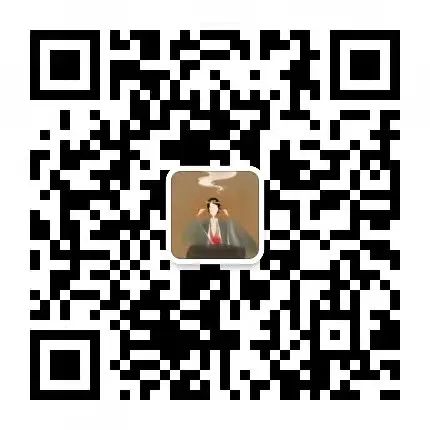Skip to content
(Report Author: Haitong Securities, Zheng Hongda, Yang Lin, Hong Lin)
1. Software at the Core, Creating a Comprehensive IoT Ecosystem
1.1 From In-Car IoT to Mobile IoT: An Industry-Leading IoT Platform.
Botaichuan IoT was established in 2009. As a pioneer in the IoT field, the company proposed the concept of in-car IoT in 2009. After 10 years of technological accumulation and development, in 2019, the company was the first to enter the mobile IoT stage, becoming the only platform in the industry to deploy mobile IoT, with a cloud platform and an in-car ecological system. Currently, the company’s business covers the entire IoT industry chain, making it one of the few comprehensive IoT service providers in the industry that can offer everything from underlying automotive software, intelligent operating systems to AI, and IoT services.
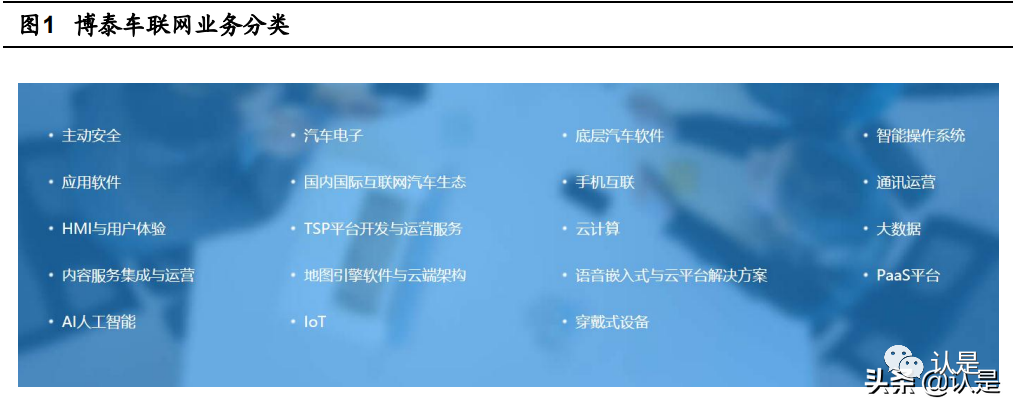
Actively embracing IoT ecosystem giants. Since its inception, the company has adhered to a geek spirit, gaining deep insights into users and the market, integrating various domestic and international innovative capabilities and technologies, and deeply integrating with resource providers to achieve good results in the IoT field.
In 2010, when Android was still version 1.5, the company launched the world’s first in-car intelligent platform based on Android OS. In April 2015, the strategic and resource advantages accumulated over the years were released. That year, the Botaichuan Project N smart car project debuted at the Shanghai Auto Show, showcasing its forward-looking R&D capabilities. In August of the same year, the B2C business, the Qingtian Intelligent Computer I.P.D.A, was launched, and in November, the first strategic cooperative investment was introduced. Since then, Botaichuan has established a sustainable development situation with a tripod of B2B, B2C, and forward-looking R&D. In June 2017, the Baidu “Leading the Future Together” partner conference was held in Shanghai, where Botaichuan and Baidu officially signed a strategic cooperation framework agreement, and the two parties began extensive cooperation in intelligent automotive solutions and services.
In July of the same year, at the Baidu AI Developer Conference, the founder and chairman of Botaichuan Group, Ying Yilun, announced that Botaichuan Group would establish a deep cooperative relationship with Baidu in the DuerOS open platform, Baidu Cloud, and the Apollo project, aiming to realize the value of massive data in the automotive and mobility fields through deep learning, making “AI empowering automobiles” possible. In 2018, the company created several industry firsts: it developed the world’s first digital cockpit hardware platform with NXP based on the iMX8 highest chip level; it deeply cooperated exclusively with Baidu DuerOS to launch the first IoT product based on AI capabilities; and it established the first hardware and software cloud platform based on hardware chips for security, authentication, eSIM cards, and large payments through three years of cooperation with NXP, UnionPay, and Baidu Cloud. In 2020, Botaichuan gathered funding from four major giants: Dongfeng, Xiaomi, and Haier, further accelerating the construction of a comprehensive IoT ecosystem. In 2021, the company reached a strategic cooperation with China Automotive Innovation to jointly establish an independent and controllable intelligent connected vehicle ecosystem.

1.2 Core Technologies Independently Developed, Clear Shareholder Resource Advantages
Insist on independent innovation, vigorously layout core IoT technologies. As an innovative IoT enterprise, the company’s technological R&D has never stopped. According to the Botaichuan IoT WeChat public account, at the beginning of its establishment, the company invested 9 million yuan in technology R&D and intellectual property, equivalent to 30% of the total operating expenses at that time. As of 2021, the company had accumulated 4,380 intellectual properties, a 19.35% increase compared to 2019. Among them, invention patents accounted for 82%, with 849 authorized. According to the Botaichuan IoT WeChat public account citing Zhihuiya, in the field of autonomous driving, the company has applied for 512 patents, ranking sixth, and is the first among IoT product and service providers, also the only IoT product and service provider in the TOP10.
According to the Botaichuan IoT WeChat public account citing China Automotive Consulting’s “2020 China Automotive Patent Statistics”, in 2020, Botaichuan IoT ranked second in the number of intelligent connected vehicle patents disclosed, with 612 cases and a year-on-year growth rate of 77%, second only to Toyota. Among them, in connectivity, the company ranked second with 428 patents, second only to Huawei. The company has been continuously increasing investment in independent innovation and R&D to maintain its technological leading advantage, achieving breakthroughs in multiple technologies from “0 to 1”. At the same time, the company is cooperating with clients such as Dongfeng, SAIC-GM Wuling, and FAW to establish R&D centers and open all technologies to leading automotive manufacturers, aiming to build a research and development team of 15,000 people within three years. We believe the company has successfully established a technical moat centered on IoT, and the model of deep binding with leading automotive manufacturers through technology delegation is conducive to the company’s business expansion in the field of intelligent connected vehicles, realizing the “Botaichuan + complete vehicle manufacturers” technical ecological alliance.
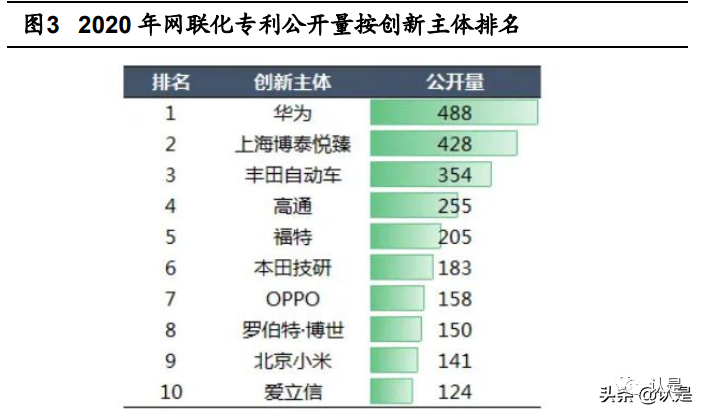
Rich Shareholder Resources. According to Ai Qicha financing data, in 2015, the company received 120 million investment from Hongma Capital in Series A. In 2017, the company received 300 million investment from Suning. Between 2019 and 2020, the company received strategic investments from several internet giants, including an additional 200 million strategic investment led by Suning in 2019. In 2020, the company successively obtained strategic investments from Dongfeng Group, Xiaomi Group, and Haier Group.
The founder is the actual controller, and the company’s control is stable. According to Qichacha shareholder information, the main operating entity of Botaichuan IoT, Shanghai Botaichuan Yuezhen Electronic Equipment Manufacturing Co., Ltd., has a controlling shareholder who is the legal representative Ying Zhenkai, holding 34.04% of the shares. Suning Group indirectly holds 10.61% of the company’s shares through Jiangsu Suqiao Suning Rundong New Consumption Service Industry M&A Fund, making it the second-largest shareholder. Xiaomi Group indirectly holds 8.18% of the company’s shares through Tianjin Jinmi Investment Partnership, making it the third-largest shareholder.
1.3 Software at the Core, Creating a Complete Closed-Loop Business Capability for IoT Hardware and Software
Constructing an M²AC Variable-Based 1+1+N Ecological Map. According to the Auto Parts Ecological Circle WeChat public account, in 2019, during the launch of the New Baojun RC-6, Botaichuan Group founder Ying Yilun proposed the 1+1+N IoT ecology. The first 1 is the in-car system, the second 1 is the mobile phone, and N includes headphones, smart wearables, smart office, and other IoT devices. The connections of these hardware are facilitated through the M²AC variable, where M² is mobile + mobility, A is AI, and C is Cloud + Big Data. In the era of industrial internet with all things interconnected, we believe automotive manufacturers must enter the “mobile travel mega-ecosystem”. Cars are mobile, phones are mobile, and artificial intelligence becomes crucial; cloud and big data give rise to new value.
The M²AC variable will drive the value reconstruction of the entire automotive industry chain. Based on this technological logic, the company positions itself in the business middle platform of the comprehensive IoT ecosystem, breaking the product islands of the traditional all-in-one model, achieving the fusion and interconnectivity of different company products. The company divides the entire business middle platform into in-car IoT platform, mobile IoT platform, and comprehensive scenario platform, and has engaged in deep cooperation with manufacturers from different fields, such as Botaichuan’s cooperation with New Baojun, and the cross-border collaboration with UnionPay, Ping An, etc., to develop new retail, finance, new services, new manufacturing, and new membership in automotive. In these collaborations, the business middle platform is expanding more business growth points for enterprises, becoming a new gateway to the future for businesses.

Possessing Complete Closed-Loop Business Capability for IoT Hardware and Software. According to the company’s official website, Botaichuan currently provides products and solutions covering everything from underlying technology to software architecture, data middle platform, and the entire IoT business ecosystem. In terms of software architecture, Botaichuan independently developed an industry-leading intelligent voice interaction system—Qing AI, in-car IoT operating system—Qing OS, intelligent cloud platform interaction system—Qing CLOUD, intelligent map interaction system—Qing MAP, and Qing Vehicle-data, which together form the underlying software architecture that deeply connects vehicles with future smart cities. In hardware, Botaichuan has a deep strategic partnership with NXP, one of the world’s largest automotive chip companies, and their collaboration in security chips and automotive chips is in the communication stage. The broadband internet-based in-car intelligent hardware platform, Qing Core, has been applied in multiple first-tier OEMs such as BAIC, Dongfeng, DPCA, SAIC, Geely, and Foton, with nearly one million automotive products. The Qing Core products have a rich selection of chips and configurations, covering color screen radios, in-car pads, front and rear entertainment systems, intelligent IoT systems, instrument and entertainment terminals, and entertainment platforms, integrating with autonomous driving and ADAS to provide an unparalleled user experience beyond that of smart phone users.

1.4 Partnering with Huawei and Others, Continuously Increasing Customer Base
Partnering with Huawei for Comprehensive Cooperation in the IoT Field. According to Zhixiangdongxi citing Cheyun.com, in October 2018, Huawei and Shanghai Botaichuan signed a strategic cooperation agreement. The two parties will collaborate in the fields of cloud computing, big data, AI, IoT, and autonomous driving based on Huawei’s OceanConnect platform, leveraging each other’s channels, technologies, products, and ecological advantages to provide more advanced IoT software and cloud platforms for the global and Chinese markets.
At the same time, the company actively implements an open, win-win negotiation and cooperation strategy, reaching cooperation with complete vehicle manufacturers such as Dongfeng and FAW, internet manufacturers such as Xiaomi, automotive chip manufacturers such as NXP, and software service providers such as Here, enriching its product line while achieving deep integration of different products, forming a large ecosystem in the segmented field of IoT. For example, Windlink is an AI in-car system jointly developed by Botaichuan and Dongfeng, and its 5.0 version has been installed in the Dongfeng Fengshen AX7 PRO, which not only brings a revolutionary change in visual experience but also uses interactive interface design to significantly enhance the sense of technology; it can also achieve intelligent interconnection between mobile phones and in-car systems, enabling remote operations with a response time of seconds; it introduces expandable ecological services, providing users with a more convenient interactive experience. Windlink 5.0 debuted the Fengshen Fast Application Platform, which is a fast application platform jointly developed by Dongfeng, Botaichuan, and Xiaomi. Currently, the cooperation between Dongfeng and Botaichuan is still ongoing, and Windlink 6.0 will be unveiled soon.
With years of technological accumulation and product delivery experience, the company has accumulated a large number of clients during its development. Currently, the company’s clients cover nearly 30 automotive brands, including luxury, joint ventures, and independent brands, with nearly 100 vehicle models and over 200 vehicle iterations, maintaining rapid growth each year. Among its clients are leading central enterprises such as FAW, Dongfeng, and Changan; leading local state-owned enterprises such as SAIC-GM Wuling, BAIC, and BAIC New Energy; leading luxury and joint venture brands such as Porsche, FAW Volkswagen, FAW Audi, and SAIC Volkswagen; as well as leading private enterprises such as Great Wall and Geely. (Report Source: Future Think Tank)

2. The Automotive IoT Industry Market is Vast, and the Industrial Ecosystem is Becoming Richer
2.1 Clear Industry Trends, Huge Potential in the Chinese Market
All things interconnected is the endpoint of IoT. The concept of IoT is derived from the Internet of Things, using vehicles in motion as information perception objects, leveraging new generation information communication technologies to achieve interconnection between vehicles, people, roads, and clouds, enhancing the overall intelligent driving level of vehicles, providing users with safe, comfortable, intelligent, and efficient driving experiences and transportation services, while improving traffic operation efficiency and enhancing the intelligence level of social traffic services in a new transportation ecosystem. IoT has three interaction levels: intelligent interaction, in-car interconnection, and internal-external interconnection. Among them, intelligent interaction is an innovation in interconnection methods, where cars are no longer passively awakened but can actively communicate with the owner based on predetermined programs and logic, deeply perceiving the internal and external environment. In-car interconnection expands the in-car interaction interface from a single central control screen to a multi-system control and sensing of more devices and interfaces, while the controllable content has increased from a few functions to cover most functions of the entire vehicle. Internal-external interconnection includes interconnection between vehicles (V2V), vehicles and roads (V2R), vehicles and networks (V2I), and vehicles and people (V2H), among several entities, achieving vehicle self-networking and communication and roaming between various heterogeneous networks, forming ecological interconnectivity, ultimately making intelligent connected vehicles part of smart cities.
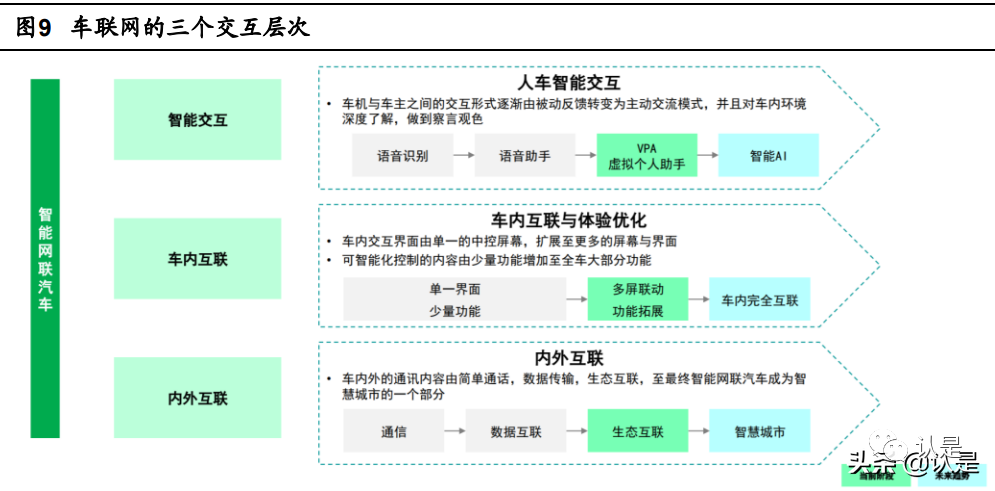
The Cross-Industry Integration System of IoT is Taking Shape, and Industrial Space is About to Open. According to Leqing Think Tank’s selected WeChat public account, China’s IoT started in 2009, going through the initial stage (supporting remote calls), the mobile internet stage (sharing mobile applications with cars), the automotive IVI stage (in-car entertainment centered around the central control screen), and the 5G+V2X stage. Currently, the cross-industry integration system of IoT has taken shape, providing auxiliary driving or conditional autonomous driving through obtaining roadside traffic information for integration, calculation, and decision-making in the car. We believe that with the maturity of 5G and V2X technologies, the IoT industry will open up growth space.
The Scale and Penetration Rate of China’s Intelligent Connected Vehicle Industry are Growing Rapidly. According to data from the Forward Industry Research Institute, since 2016, the scale of China’s intelligent connected vehicle industry has gradually accelerated, reaching a market size of 255.6 billion yuan in 2020, with a growth rate of 54.30%. It is expected that the industry will maintain rapid development in the next six years, with the market scale reaching 585.9 billion yuan by 2026. At the same time, the penetration rate of intelligent connected vehicles will also maintain rapid growth.
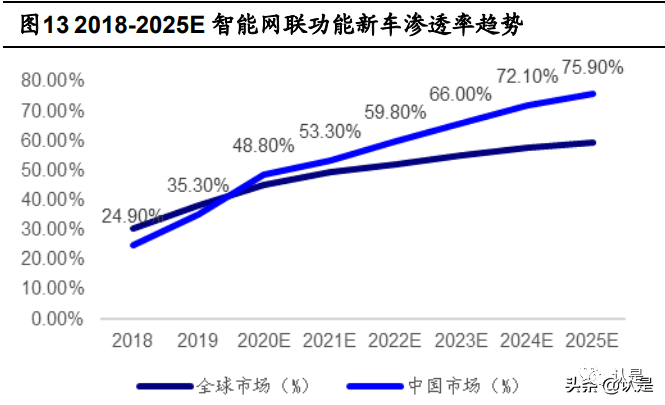
2.2 The “Cloud, Pipe, End” Industrial Ecosystem is Becoming More Complete
The Structure of “Cloud,” “Pipe,” and “End” is Gradually Perfecting Under Deep Integration. The IoT industry chain can be analyzed from three levels: “cloud,” “pipe,” and “end.” The “cloud” level mainly involves service industry roles, including software and data providers, public service, and industry service providers. The “pipe” level balances the roles of manufacturing and service industries, mainly including equipment providers and communication service providers. The “end” level is primarily composed of manufacturing industry roles, including complete vehicle manufacturers, automotive electronic system providers, component providers, and in-car software providers.
From an application perspective, IoT applications mainly include three areas: the in-car information service field has diverse market entities and roles, with technology companies like Tencent, Botaichuan, and Four-Dimensional Map New establishing a rich business puzzle covering map navigation, audio-visual entertainment, operating systems, OTA, and IoT security; the digital operation field, where IoT cloud platforms and big data platforms are core assets, and technology giants are deeply laying out enterprise services and mobile travel, with companies like Feichi Meiwul, Hongquan Wulian, and Ruiming Technology deeply cultivating vertical markets in logistics and passenger transport; and the vehicle-road collaboration field, where under the leadership of Huawei and China Mobile, the internet, ICT industry, and automobiles and transportation are moving towards deep integration, and the “cloud,” “pipe,” and “end” industrial chain structures are gradually improving.
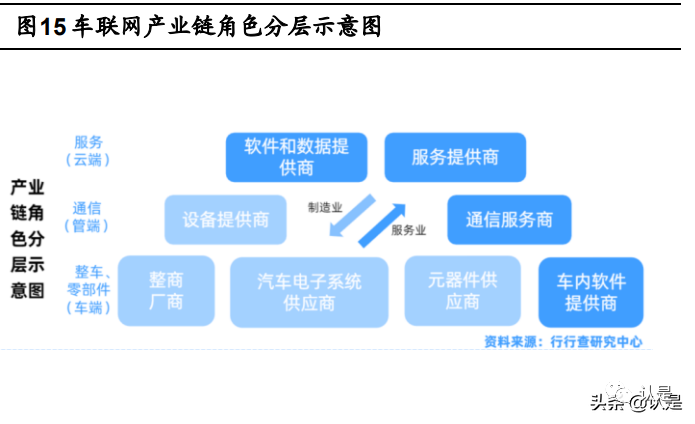
The Variety of In-Car Information Service Businesses. In-car information services are the first developed IoT business, mainly including navigation, audio-visual entertainment, vehicle monitoring, remote upgrades, and information security. With the support of mobile communication and big data technologies, the service content and boundaries are constantly expanding. Due to its strong mobile internet attributes, it attracts numerous internet and technology companies to cross into the field. According to the Intelligent Connected Vehicle Network citing the Sohu Auto Research Room’s comprehensive ranking of in-car information service companies, the field includes traditional IoT service providers, map providers, as well as emerging internet cross-border companies, automotive electronic suppliers, and security companies, with diverse market roles and varied business types. The major players in terms of market size and business volume are internet and automotive technology giants.
The Traditional Information Service Field Has High Barriers, and Customized Operating Systems and Special Applications are the Main Focus of Internet Companies. According to the Intelligent Connected Vehicle Network citing Sohu Auto Research Room, from the perspective of corporate business layout, customized in-car operating systems and special application development are key areas for internet companies entering the IoT field. Personalized human-computer interaction, mobile interconnection, OTA, etc., continuously enrich the functional experience of intelligent cockpits, while IoT security is gradually gaining industry attention, with in-car IoT and mobile IoT gradually moving towards integration. In the traditional in-car information service field, there are qualification barriers, and the market structure is stable, with major service providers in the industry such as Gaode and Four-Dimensional Map New.
In terms of hardware, Four-Dimensional Map New, Botaichuan, Neusoft Group, Beidou Xingtong, and Suoling Co., Ltd. have achieved good development in the pre-installed digital instruments, in-car large screens, T-BOX, OBU, and post-installed streaming media rearview mirrors, driving recorders, and other in-car intelligent terminal markets. In terms of software, Tencent, Zebra Network, Huawei, etc., are all laying out the construction of in-car operating systems and application ecosystems. In the OTA field, Tencent and Four-Dimensional Map New provide software upgrade services related to their businesses for supporting in-car systems, while Alibaba and Neusoft Group delve into automotive control domains, providing software and firmware upgrade services for automotive manufacturers as third parties.
In the field of IoT security, companies like Tencent have established IoT security teams to conduct research on IoT security offense and defense; the 360 Intelligent Connected Security Laboratory has launched the “Automotive Security Brain” to provide software and hardware information security protection for automotive enterprises and is preparing to initiate the “China IoT Security Alliance.” Beyond these segmented fields, Botaichuan and Meixing Technology, as comprehensive IoT service providers, are dedicated to providing complete hardware and software solutions for complete vehicle enterprises.
The digital operation of IoT is based on in-car intelligent terminals and in-car software as entry points, with IoT cloud platforms and big data platforms as core assets, achieving a digital “reconstruction” of mobile travel, the automotive aftermarket, as well as logistics, passenger transport, and taxi vertical industry applications, significantly enhancing production, operation, and service efficiency, with enormous market potential.

Digital Operation Plays a Connecting Role in the IoT Industry. IoT digital operators occupy a core position in the IoT industry chain, connecting upstream IoT intelligent terminal manufacturers and downstream applications and services of the entire automotive aftermarket. From the perspective of the entire industry chain’s service and content output, IoT digital operators occupy a core position, serving as the “central hub” connecting all IoT services. According to Yiou Think Tank, IoT digital operations will form an operational pattern led by automotive manufacturers, with telecom operators, internet companies, and third-party technology companies as core players.
Comprehensive Empowerment of Digital Services is Mainstream, with Strong Demand for Aftermarket Solutions. From the perspective of corporate business layout, unlike traditional in-car information services, the IoT digital operation service business targets primarily enterprise clients. This market has strong demand for aftermarket solutions such as T-BOX, OBU, and in-car monitoring terminals like driving recorders and GPS. The main business model of digital operation companies is to achieve comprehensive empowerment of mobile travel, automotive aftermarket services, automotive financial services, and enterprise digital services through IoT cloud platforms or big data platforms. In automotive finance, aftermarket services, and travel service markets, Botaichuan, Feichi Meiwul, and Dina Technology showcase their advantages in integrated business, providing hardware and software development and big data, cloud platform operation services tailored to different customer needs.
In terms of vehicle-road collaboration construction and operation, C-V2X vehicle terminals, roadside units, and overall solutions for vehicle-road collaboration have become key areas of industry layout, forming a batch of innovative enterprises that have taken the lead in research and development and application pilot projects, effectively supporting the construction of demonstration zones across the country and promoting the process of IoT applications.
Vehicle-Road Collaboration Enterprises Show Diverse Layouts. According to the Intelligent Connected Vehicle Network citing Sohu Auto Research Room statistics, 13 leading enterprises include communication companies (Huawei, ZTE, Gao Hong Co., Ltd.), operators (China Mobile), internet companies, automotive technology service providers (Four-Dimensional Map New, Neusoft Group), intelligent transportation companies (Qianfang Technology, Gaoxin, Wanjiji Technology, Jinyi Technology, Xingyun Interconnection), and module companies (Yuan Communication), covering different industrial chain links of C-V2X “end,” “pipe,” and “cloud,” with most enterprises demonstrating diversified business layouts.

From the perspective of corporate business layout, the upstream of the industrial chain includes communication chips/modules, protocol stacks, security solutions, and testing certification technologies, which have high barriers to entry, currently dominated by ICT companies. Huawei and Gao Hong Co., Ltd. have taken the lead in achieving breakthroughs in self-developed C-V2X chips, while China Mobile and Neusoft Group have made outstanding contributions in C-V2X standard formulation and testing certification. In the midstream of the industrial chain, vehicle communication terminals and RSU roadside units supporting C-V2X have achieved mass production, with current market demand primarily coming from intelligent connected test vehicles and demonstration zone and road construction. In the downstream of the industrial chain, application scenarios based on C-V2X for autonomous driving are being widely tested in pilot areas and demonstration zones such as Wuxi and Tianjin, with commercial and operational models yet to be clarified.
2.3 Competition in the IoT Field Enters the Second Half, Ecological Cooperation is the Trend.
According to Yiou data, 2017 was the most concentrated period for financing related to IoT companies in China, with 187 financing events. After that, the industry began to move towards competition and cooperation, with capital concentrating on leading enterprises, and the number of financing events declining from 2018 to 2020. In 2020, the IoT field was one of the most watched areas in the capital market, with a total of 75 financing events in China’s IoT-related fields from January to December 2020. Among the financed companies, those in the angel round were the most, followed by Series A and B, with varying quality of financing.
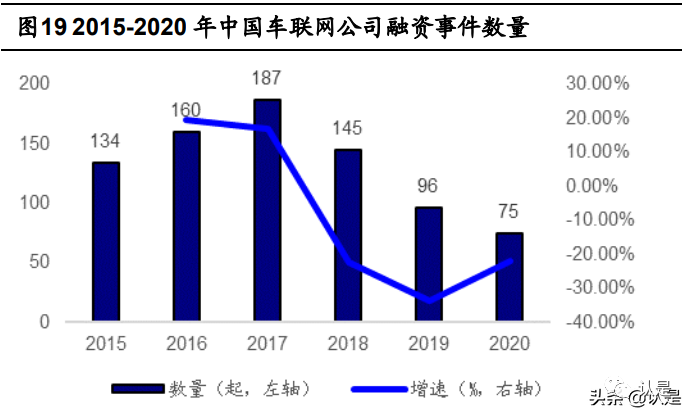
3. “Qing” Series Core, Focusing on Building a Software Technology Base
“Qing+X” Creates a Product Line for Integrated Innovation in the IoT Industry. According to Botaichuan’s official website, based on over 10 years of vigorous development, Botaichuan has grown into one of the few comprehensive IoT service providers in the industry that can offer everything from intelligent operating systems, big data, content service integration and operation, map engine software and cloud architecture, to voice embedded and cloud platform solutions. Currently, Botaichuan has various product lines including Qing Core, Qing OS, Qing Map, Qing AI, Qing Cloud, and Qing Pay, integrating automotive electronics, software, cloud platform services, and business model innovation into one, connecting the internet and automotive industries. (Report Source: Future Think Tank)
3.1 Qing AI: Voice is an Important Interaction Entry for IoT.
A Full-Chain Voice Solution with Full Data Integration and Complete Scenario Closure. At the forefront of human-computer interaction in intelligent vehicles, Botaichuan IoT’s Qing AI voice open platform, with its integrated full-chain voice solution for both mobile and in-car systems, has become one of the “optimal solutions” for vehicle manufacturers’ voice interaction capabilities. Botaichuan is the first company in the world to develop Chinese in-car voice technology and is one of the few IoT companies in the industry with a voice platform. Currently, Botaichuan has built a voice open platform in collaboration with professional voice companies such as Baidu AIG, Xiaomi, Vivo, iFlytek, and Sibo, as well as professional voice robots like Xiaobing, and can customize microphone arrays, skills, and voice actors to create an AI SDK empowering the automotive sector in just five minutes. Currently, the Qing AI voice open platform has iterated to version 3.0, truly achieving full-chain technology, full data integration, and complete scenario closure.

Pre-set configurations for different clients’ ASR, NLU, and TTS recommendations. The Botaichuan Qing AI platform controls the entire voice processing flow based on full-chain configurations, including ASR (Automatic Speech Recognition), NLU (Natural Language Understanding), and skill services, TTS (Text-to-Speech), and front-end display, with all configurations supporting online real-time updates that take effect immediately without affecting normal service in the production environment. ASR can configure NLU suppliers used in specified scenarios, VAD duration, dialects, etc., and can use the platform’s preset recommended configurations, with each project able to customize configurations based on client needs. NLU and skill services can configure NLU suppliers and the scope of skills per project. Based on the NLU foundational semantic understanding, Botaichuan’s self-developed skill services, central control modules, and dialogue context management achieve optimal results in natural language dialogue scenarios. TTS can configure TTS suppliers, voice actors, dialects, etc., based on the platform’s preset recommended configurations, allowing for selective customization as needed.
The Qing AI voice open platform has five major product features. According to the Botaichuan IoT WeChat public account, the Qing AI voice open platform has platform capabilities that enable precise and efficient voice distribution, multi-skill result arbitration while providing pluggable custom services for product iteration and upgrades. The platform can provide different skill voice services according to project needs for each project and model, achieving efficient and flexible customization supporting different business needs with a single service. It also supports two major in-car system camps, Linux and Android, allowing for rapid adaptation to vehicle manufacturer projects, flexibly achieving efficient one-to-many applications. At the same time, the Qing AI voice platform provides over 40 fields and more than 1,000 scenario services, covering users’ travel, media, entertainment, business, dining, accommodation, social, and various aspects of daily life, connecting cars with smart home devices, TVs, watches, sensors, drones, and other IoT terminals, realizing the interconnectivity of everything at the scenario and device level.
In terms of interaction methods, the Qing AI voice platform can provide real-time, thoughtful life reminders and recommend various life services through multi-sensory fusion interaction methods such as user preference analysis, image recognition, gesture interaction, and emotional perception. In terms of performance, Qing AI can achieve 22 POI navigation searches within 30 seconds, with an accuracy rate close to 100% in environments with noise levels of 90 decibels and speaking at 45 decibels, providing users with an ultimate experience that is fast, accurate, stable, and clear.
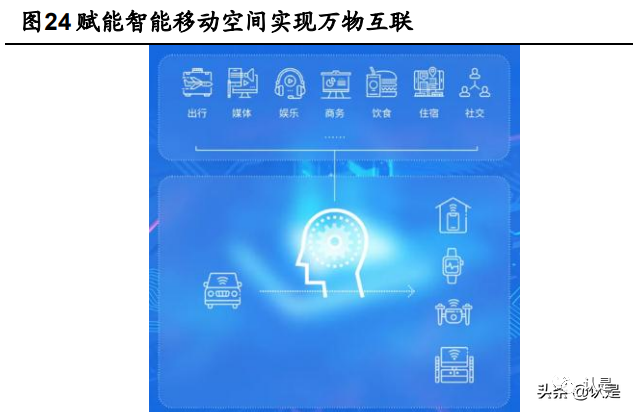
High Accuracy and Short Feedback Time. According to the Botaichuan IoT WeChat public account, in terms of reliability, the Qing AI voice platform guarantees timely feedback of voice services at the in-car end in seconds. The time from when the user starts speaking to the first word feedback is within 800ms, and the time from when the user finishes speaking to the full recognition result feedback is within 75ms; the feedback time for semantic analysis is stable at within 150ms; and the CP feedback time is 90% stable within 1s. When the device runs for more than 1 day, the wake-up rate and recognition accuracy remain above 95%; in terms of resource usage, Qing AI maintains memory stability around 200MB, with extremely low system resource usage, saving hardware costs for the device.
3.2 Qing Mobile: Mobile IoT
The Mobile Phone Becomes the Brain of the Car. According to the WeChat public account of Smart Vehicle Industry Vision quoting Yiou, in 2019, at the launch of Botaichuan’s mobile IoT product, the founder Ying Yilun announced the new in-car interconnection system “Qing Mobile”. This system installs the Botaichuan OS cloud on the user’s phone, allowing the OS cloud account to be integrated into the car, making IoT not just a tool used for 2 hours while driving, but truly achieving 24-hour mobile IoT. Qing Mobile not only maps any app on the phone to the large screen but can also start the car remotely; it can use voice to wake up most functions in the car, including navigation/entertainment/sending and receiving WeChat messages; it can use voice capabilities and cloud capabilities developed by Botaichuan and its partners.

Cost Reduction + Ecological Closed Loop as a Distinctive Advantage. According to the WeChat public account of GeekCar, the distinctive feature of Qing Mobile is that the computing power required for these applications and most of the data traffic are provided by the phone, eliminating the need for OEMs to have “smart in-car systems” or bear operating data traffic costs. A conventional in-car system generally consists of four parts: T-BOX, in-car system, large screen, and operating costs. Botaichuan’s Qing Mobile only retains the T-BOX and large screen, with the phone’s computing power replacing the in-car system and the phone’s data traffic replacing the operating costs. At the same time, the phone can also unlock/control the vehicle, eliminating the need for a car key.
In terms of ecology, Qing Mobile has its own ecological closed loop and can also map all apps on mainstream smartphones, covering a wide range of ecosystems. Currently, most in-car systems collaborate with BAT, all willing to provide their full ecosystem to OEMs. However, users’ usage habits vary, and BAT’s capabilities differ in various aspects, often causing mismatches between demand and supply. Qing Mobile is compatible with various domestic and international in-car interconnection products and automotive applications, currently supporting Apple Carplay, Google Android Auto, Gaode Amap, Four-Dimensional Welink, Kuwo Music, Himalaya, and many other mobile interconnection and application ecosystems, allowing customers to choose according to their preferences and adjust according to changes in times, providing users with the best experience.
Mobile IoT Has Advanced Hardware Capabilities. According to the WeChat public account of GeekCar, the current automotive development cycle is generally 3-4 years, while that of mobile phones is 9 months, meaning that automotive hardware is already two generations behind by the time the car is launched, and the ten-year lifecycle causes both software and hardware of in-car systems to lag behind mobile phones. Currently, mainstream mobile phone chips are nearly 20 times faster than mainstream automotive chips; their startup speed is 100 times faster than current common IoT solutions and 15 times faster than traditional in-car systems; connection speed is 60 times faster. We believe that Qing Mobile can keep vehicles advanced in hardware by embedding mobile computing power into cars, leveraging users’ habits of replacing phones every 1-2 years. Currently, Qing Mobile has been successively installed in hot-selling models from SAIC-GM Wuling, Geely, Dongfeng, BAIC, and some joint venture brands.
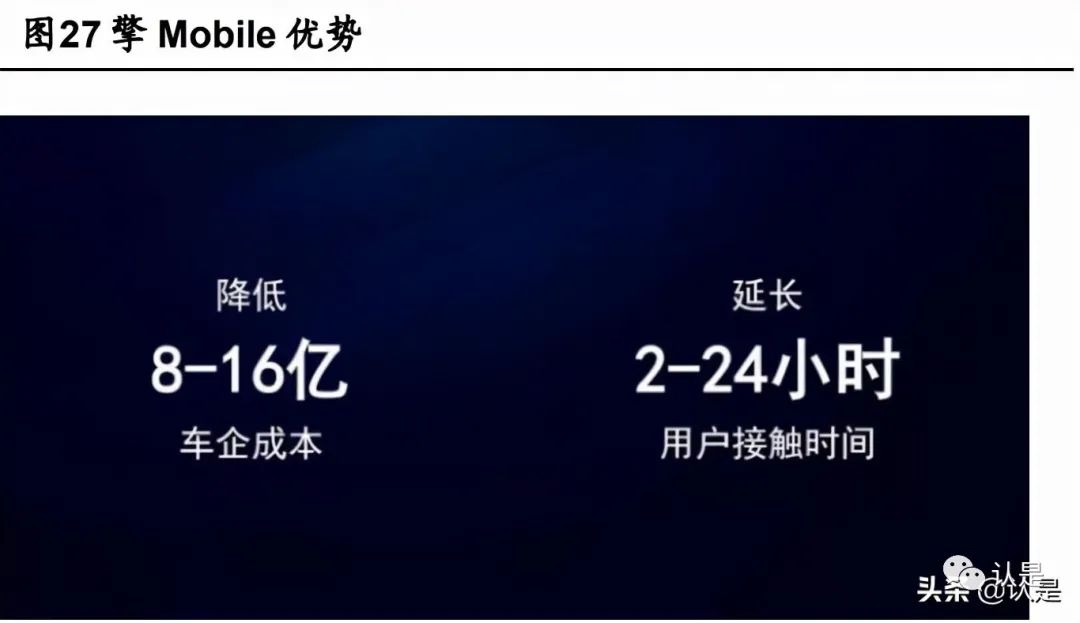
3.3 Qing Map: A Comprehensive Map Data System
Comprehensive Map Data, Cloud Traffic Data as Effective Supplement. Botaichuan places travel data and vehicle location data at the core of IoT, building a map data system centered on Qing Map. Qing Map supports map data and road condition data from Baidu, Here, Four-Dimensional Map New, and Gaode through its own engine, software, and cloud data architecture, while also supporting the integration of various cloud traffic data, including road, weather, flight, intelligent transportation, and smart city data, providing global map service capabilities for China, the US, and Europe. Through real-time data interaction with the internet, Qing Map can provide richer map and travel services on inexpensive hardware. The cloud-based Qing Map and travel data services can provide various big data analysis capabilities such as driving habit analysis, common location analysis, dangerous driving analysis, and trajectory monitoring analysis.
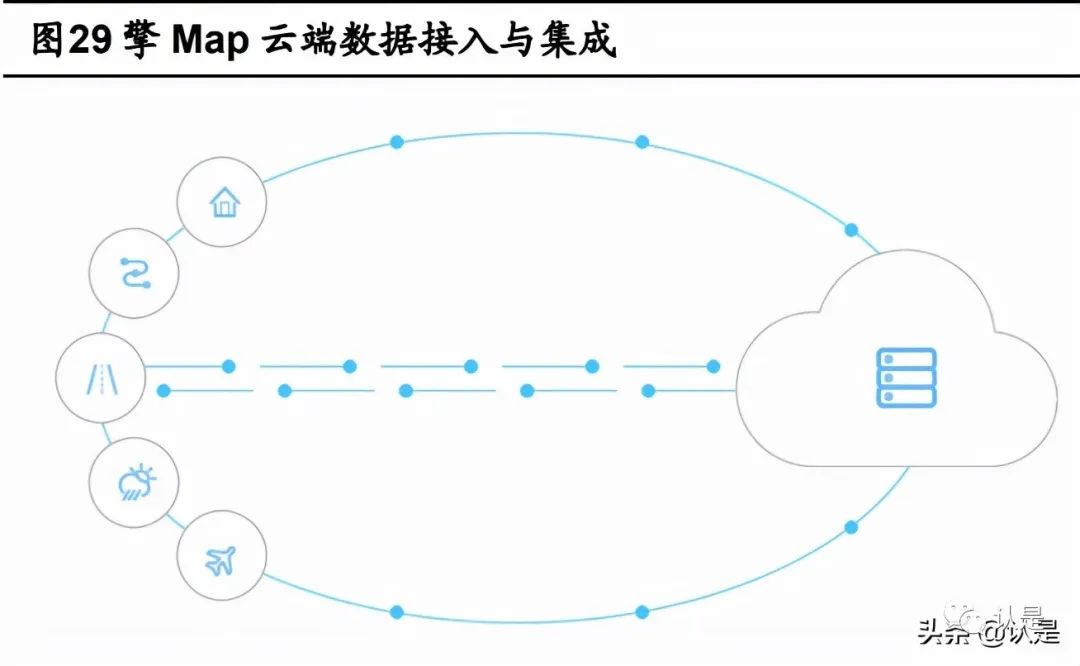
Strong Map Data Derivation Capabilities. Qing Map can also combine with other applications and services to provide richer map data derivation capabilities. For example, Botaichuan cooperates with Suning and Here to create international map services based on “Qing Map + Qing Global Map Services”. Suning provides Botaichuan with application download services for 20 million mobile phones annually and offers virtual communication for global roaming services and internet financial leasing services. Here and Botaichuan have established a service data center in Germany to provide international map downloads. Users only need to download an application software and pay a daily rental fee before going abroad to use the Chinese global map navigation product without data roaming fees. Based on Botaichuan’s high-precision maps and all autonomous driving sensor data from Germany’s top three groups, the combination of “Qing Map + Qing HD Map” can provide high-precision maps and data cooperation capabilities related to autonomous driving.
3.4 Qing Cloud: A Cloud Platform with Tens of Millions of Users Based on Microcontainers
A Cloud Platform with Tens of Millions of Users Based on Microcontainers. IoT platforms generally can only serve millions of users, while Botaichuan’s cloud platform, based on microcontainer processing methods, can serve tens of millions of users with significantly increased service capabilities. Botaichuan has made significant reconstructions and improvements to the cloud platform architecture while ensuring high security of IoT data and transmission, greatly enhancing service capabilities, agility, user load, concurrency capabilities, and demand iterations by dozens of times. Based on Qing Cloud, Botaichuan has built map platforms, big data platforms, OTA platforms, PaaS platforms, etc., and launched the Qing All Value Chain Platform, which can provide customers with services around driving, including refueling, charging, UBI insurance, parking, car washes, maintenance, O2O home services, chauffeur services, rental, user services, used car services, automotive finance, etc.
There are automotive industry groups for complete vehicles, key parts, new energy vehicles, intelligent connected vehicles, aftermarket, automotive investment, autonomous driving, IoT, and dozens of other groups. Please scan the administrator’s WeChat to join (please indicate your company name). There is also a startup financing group, and angel round and Series A companies are welcome to join.

















